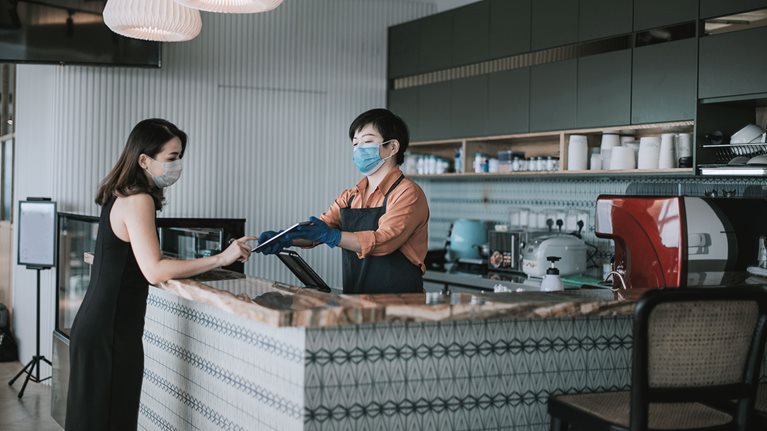This article was a collaborative effort by Elaine Dang, Samuel Huang, Adrian Kwok, Harrison Lung, Michael Park, and Emily Yueh.
The experiences of Asian Americans in the United States have been marked by a basic contradiction.1 At 20 million strong—nearly 6 percent of the US population—they are a powerful economic force: nearly two million Asian American–owned small businesses generate $700 billion in annual GDP and employ around 3.5 million people.2 Asian Americans have been part of the country’s tapestry dating back to the 1800s. But despite wide-ranging contributions to US society, they have historically been overlooked. Indeed, the common perception of Asian Americans as the “model minority,” excelling and assimilating, has led many people to not view them as marginalized at all. This dynamic often excludes them from diversity initiatives, leading to underrepresentation in business and politics and leaving many without support in navigating persistent language barriers.3
The COVID-19 pandemic’s comparatively deep impact on Asian American—and other communities of color—has exposed the gap between perception and reality. A look beneath the top-line numbers reveals that the Asian American community is not a monolith: Asian Americans have some of the widest variances in corporate success, educational attainment, and income. The community’s workers disproportionately hold high-contact essential jobs that place them at greater health risk. Asian-owned businesses are overrepresented in sectors that have been hardest hit by COVID-19. Further, the pandemic has exacerbated anti-Asian xenophobia and racism, which have historically acted as barriers to equity.
As the country’s stakeholders in the public, private, and social sectors look toward recovery, the Asian American community will be a critical engine. The Asian American population is projected to become the largest immigrant group (38 percent of immigrants) in the United States by 2055, so raising awareness of the community and addressing inequities within the group are increasingly urgent.4 Gaining a greater understanding of Asian Americans—the true picture of their experiences, strengths, and challenges—is vital (see sidebar “A primer on the Asian American experience in the United States”).
This article aims to do the following:
- Equip stakeholders in the public, private, and social sectors as well as individuals with a set of demographic data on Asian Americans
- Identify disparities, exposed by COVID-19, that have affected Asian Americans
- Share actionable opportunities for private and public leaders to achieve equity for Asian Americans during the COVID-19 recovery and for individuals to contribute to the dialogue—actions that could also support all groups experiencing a disproportionate impact from the crisis
Key demographic data for decision makers
Asian American immigrants and their descendants are diverse both culturally and socioeconomically (Exhibit 1). A deeper look at the Asian American community highlights potential blind spots in business-decision and policy making, as well as in broader inclusion and equity efforts.

The impact of COVID-19 on Asian American lives and livelihoods
COVID-19 has had a massive impact on all segments of US society. Asian Americans have suffered disproportionately across a number of metrics. Certain parts of the community have been at higher risk of infection and death, and rising xenophobia has worsened mental health. Asian Americans experienced an earlier decline in business and employment and—without targeted policy and business action—may recover more slowly.
Impact on health
There is a lack of accurate, disaggregated data on Asian Americans, which is crucial in assessing the health impact of COVID-19 on the Asian American population.5 While the aggregated Asian American death rate from COVID-19 is similar to that of white Americans, significant disparities emerge at the subgroup level.6 For example, Pacific Islanders are two to three times more likely to be diagnosed with the virus compared with the average in three states.7 In San Francisco, Asian Americans accounted for 13.7 percent of cases but 52 percent of deaths.8 In Nevada, Asian Americans are dying at more than twice the rate of white Americans.9
Discrimination and mental health. Asian Americans have been the target of a unique rise in racist rhetoric and discrimination (see sidebar “Anti-Asian experiences in healthcare”). Since the beginning of the outbreak, organizations have documented at least 1,900 hate incidents across 46 states, one-third of Americans reported witnessing other individuals blame Asian Americans for the outbreak,10 and reports of anti-Asian violence and assaults have been on the rise.11
Research has found that both overt racism and microaggressions can worsen mental health. These incidents are already having a notable effect on the Asian American community’s mental health. Crisis Text Line, a nonprofit group that provides free mental-health support via text message, saw a 39 percent increase in texts from Asian Americans in the first quarter of 2020. The community faced similar discrimination during the SARS outbreak in 2002,12 and studies found that this stigmatization may have discouraged affected populations from seeking care, resulting in underreported illnesses and worse health outcomes.
These mental-health challenges are complicated by additional barriers: many providers don’t offer language services for Asian patients, and mental-health treatment is often stigmatized in the Asian American community.13 As a result, only 5.8 percent of Asian Americans sought any type of mental-health services or resources, compared with 19 percent of white Americans.14
Asian American essential workers. Approximately two million Asian Americans—a higher proportion than their share of the US population—are putting themselves at risk as frontline and essential workers (Exhibit 2). This is especially true in healthcare, where Asian Americans exceed their share of the population in 72 percent of high-contact essential occupations in medical fields. Additionally, Asian American personal-appearance workers (such as cosmetologists and barbers) are employed at a relatively high rate at some of the first businesses to reopen their doors in the wake of COVID-19.

Impact on livelihoods
The Asian American business community has been particularly disrupted by a double hit of xenophobia and lockdowns. Asian American–owned businesses were some of the earliest to experience declines in business (see sidebar “Anti-Asian experiences in the restaurant industry”). A full month before nationwide lockdowns began, misguided fears of the virus effectively shuttered businesses in many Asian American cultural districts—despite few confirmed COVID-19 cases in those areas.15
Asian-owned businesses are overrepresented in some of the hardest-hit sectors. Asian-owned businesses make up 26 percent of accommodations and food service, 17 percent of retail trade, and 11 percent of education-services businesses16—sectors that have sustained some of the worst economic effects from COVID-19 (Exhibit 3).17

On employment, analysis of past economic downturns suggests that Asian Americans experience more serious and prolonged rates of unemployment. During the 2008–09 downturn, Asian American unemployment rates nearly doubled.18 Early data shows this pattern of unemployment rates being repeated during COVID-19: Asian American unemployment rates increased by more than 450 percent from February to June 2020, revealing a greater rate of increase than that of other racial groups.19 More alarmingly, while overall unemployment dropped in May 2020, it in fact grew 0.5 percentage points for Asian American workers and 0.1 percentage points for Black workers.20
The slow recovery
Recovery from the pandemic may also be protracted for Asian American businesses, which have suffered from a lack of government and financial support—as have other groups. For example, roughly 95 percent of Black-owned businesses, 91 percent of Latino-owned businesses, 91 percent of Native Hawaiian– or Pacific Islander–owned businesses, and 75 percent of Asian-owned businesses have little chance of obtaining a Paycheck Protection Program (PPP) loan because fewer minority-owned businesses have existing relationships with a mainstream bank or credit union, a prerequisite to be approved.21
The language barrier also impedes many Asian Americans from participating in relief programs. Despite Executive Order 13166, which aims to provide “meaningful access” to federal agency resources for individuals with limited English proficiency,22 translation and language resources for businesses in the wake of COVID-19 are few. None of the four financial-relief services offered by the US Small Business Administration provide translations into Asian languages on their websites. Only PPP offers any level of Asian translation for application forms—and for just seven Asian languages, out of the more than 15 most commonly spoken in Asian households.23
The recovery of Asian American businesses will be integral to the revival of entrepreneurship and employment in the country as a whole.24 In particular, the Asian American business community outperforms the national average on business ownership and employment. When asked why so many Asian Americans chose to be entrepreneurs, Mary Wong of OMG Tacos explained, “Our parents immigrated here to give us better opportunities. We personally saw them work so hard through so many challenges, and many still don’t have the resources to retire comfortably. We do it for them.”
A catalyst for change
COVID-19 has illuminated ways in which Asian Americans have been overlooked or excluded. Addressing these issues will take a concerted and sustained effort by stakeholders in the public, private, and social sectors, as well as efforts by individuals outside of the workplace. To support this mission, we have compiled a three-part list of actions for each group to consider in creating a more equitable environment.
Equitable public representation
Stakeholders in the public and social sectors have the opportunity to shape and implement better and more nuanced policy for Asian Americans. To promote longer-term equity for Asian Americans, agencies can take immediate actions toward relief and recovery:
- When serving constituents, the organization gathers data that disaggregate Asian subgroups to extract insights on the unique effects of COVID-19 and the subsequent recovery on these subgroups.
- The organization has designated an employee to track and oversee Asian American inclusion as recovery initiatives are developed, in coordination with efforts that support other underserved groups.
- The organization offers both verbal and written language assistance for all of its services and resources in Asian languages that are spoken by a meaningful number of people.
- The organization has taken concrete steps to combat anti-Asian rhetoric in public dialogue—for example, by actively denouncing anti-Asian slurs.
Inclusive and diverse business culture
In the private sector, stakeholders can harness this moment to engage Asian Americans, both within their organizations and among their consumers. We encourage companies to reflect on how they can include Asian Americans in their workplace-diversity efforts and serve a largely untapped population by taking several actions:
- The company has taken concrete steps to combat implicit bias, microaggressions, and overt xenophobia toward Asian American employees—for example, establishing clear inclusion guidelines in the workplace targeted toward Asian Americans, or implementing diversity and inclusion training that actively includes dialogue on Asian American issues for all employees.
- An employee resource group for Asian American colleagues offers robust mental-health support or office events based around the effects of the pandemic.
- The company has expanded access to and consumption of its services among Asian Americans—for example, by providing accessible language translation, tailoring credit offerings to Asian American small-business needs, and advertising to Asian American consumers.
- The company has implemented targeted efforts to support Asian-owned businesses— for example, by committing to supplier-diversity goals.
- The company has plans to measure Asian American representation in its overall diversity and inclusion strategy, especially in executive positions, acting to ensure these leaders contribute to COVID-19 recovery and reimagination.
Engaged dialogue
Individuals of all backgrounds have a critical role to play in sustaining an ongoing dialogue, holding organizations accountable, and supporting the Asian American community. Here are some steps they can take:
- Individuals have engaged peers (Asian and non-Asian) to raise awareness of inequalities experienced by the Asian American community.
- Individuals have encouraged employers or policy makers to collect disaggregated data and initiate diversity efforts.
- Consumers have supported Asian small businesses and cultural centers during the COVID-19 recovery.
- Individuals have confronted instances of racism and discrimination.
- The mental health of fellow Asians has become a priority.


